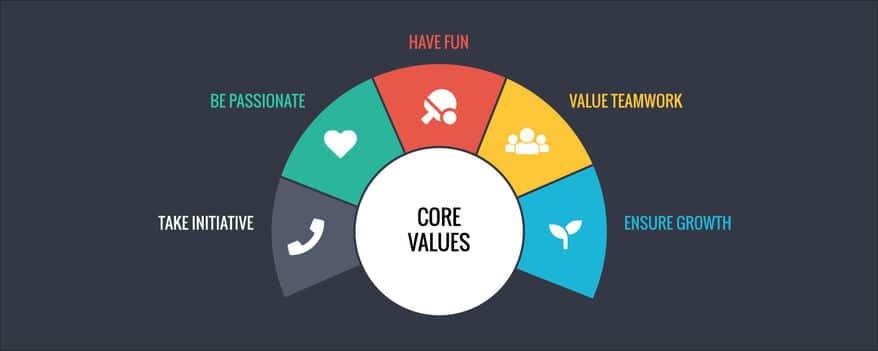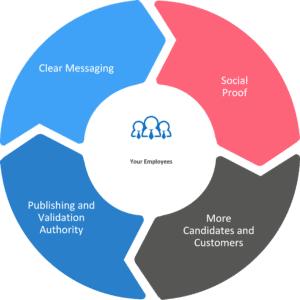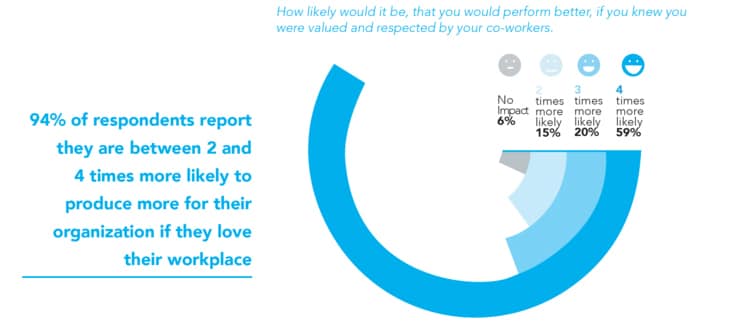How to Measure Employer Branding to Achieve High Employee Satisfaction
If you are looking to better yourself as a business to create a more enjoyable, supportive work environment for your employees, you need to consider your employer branding. The CIPD defines this as:
‘A set of attributes and qualities that makes an organization distinctive, promises a particular kind of employment experience, and appeals to those people who will thrive and perform best in its culture’.
Where To Begin When It Comes To Employer Branding
The first thing you as an employer need to do is establish a set of values and ideals that your company will uphold. What are the key points that potential employees will pick up on when deciding if they wish to apply for a position?
These can include:
- Quality of service
- Work/life balance
- Office environment
- Company culture
- Diversity and inclusion

By clearly stating where your priorities lie, you will then be able to look back and see where you are lacking if any issues arise with your employees. These values may differ slightly to your brand’s purpose as they are focused more around how attractive you are to job seekers as opposed to customers.
Means Of Measurement
There are multiple routes you can take when it comes to measuring how successful your branding is, but it can be easy to get stuck in an echo chamber after a while and lose sight of what is most important: communication.
Your metrics are only as good as the data behind them. You may excel in other areas of your business, but your workers are the driving force behind your success. If you’re not listening to your employees, it’s time to make a change. Communication is key.
Candidates
Hiring and Retention
It’s important to be aware of which positions you need to fill and why. If you find that you’re continuously having to re-hire for certain roles, consider conducting an exit interview with the workers who are leaving you.
- What factors contributed to them leaving?
- What can you do to rectify the situation?
- What advice would they give to the next new hire?
It is always more cost effective to retain current employees than to look for new ones. High employee turnover is damaging for the company, with your cost per hire often amounting to 20% more than the salary of the leaving employee.
The hiring process can also be lengthy, but by improving your employer branding you can then make your time-to-hire more effective – 200% more effective. This is because candidates will already be familiar with the principles you as an employer strive for, making your company a more attractive place to work.
It is important to keep an eye out for new potential employees and new talent. But it is more important to boost your retention rate of existing staff members and put time into improving their employee experience.
Quality and Skill of Candidates
During your recruitment process, you’ll be looking for the highest quality candidates available. But, depending on the size of your business, you’ll likely be hiring from a wide range of people, some of whom will need additional training. You need to make sure that you have everything in place to take care of and provide for your employees, regardless of their skillset or background.
Within your employer branding, pride yourself on your ability to work with your employees to boost their confidence and talent. Don’t just leave them on their own to figure things out for themselves. A good degree of problem solving builds confidence and general ability, but when presented with an unfamiliar environment many people will need a helping hand.
Moreover, consider:
- Are you the type of employer who attracts highly qualified candidates?
- If not, then why?
- What aspects of your business are stopping you from reaching that top talent acquisition?
A good benchmark for evaluating whether you are attracting qualified applicants is by looking at your applicant-to-interview ratio. The average for this has risen recently from 12% to 20%, so anything above 20% indicates that you are on the right track for attracting the correct quality of hire.
Be sure to take your hiring managers into consideration, as well. Listen to their feedback when it comes to the candidate pool. If they have concerns, act on them. Hiring managers should act as a neutral third party who can offer unbiased advice on candidates and their capabilities. They are one of the first points of contact when it comes to making a decision.
The quality of the people working for you reflects well on your branding and what type of business you are running. As well as nurturing new talent, you also need to be attractive for developed employees who are looking to further and better their opportunities in their selected field.

Number of Applicants and Acceptance Rates
While you may have avenues to reach out to people (e.g. using recruitment agencies), how many of the candidates you contact actually want to work for you?
If the number of applications you receive for an opening is low, go back and look over your advertised job description:
- Have you set unrealistic expectations?
- Are you attractive to a diverse range of people?
- Have you included any information about the benefits of working at your company?
- How easy is the application process?
- How easy is it to find out about your company and what you stand for?
Establishing a good careers page can help increase the number of candidates you receive. A dedicated space that is easy to navigate and contains all the relevant information that a candidate would be looking for saves them valuable decision-making time. By including everything an applicant needs in one area, you are improving the candidate experience.
Right from the start, you need to show that you are willing to do what it takes to help any future employees. Dedicated areas to ask questions, as well as a quick turnaround between hearing from applicants, and getting back to them with job offers, are all signs of strong employer branding. You are taking initiative when it comes to making candidates feel welcome and included.
Employees and EVP
Your EVP (Employee Value Proposition) acts as a foundation for your employer branding strategy, allowing you to focus on the elements that matter most.
TalentLyft identifies several key points of focus when it comes to EVPs. By making sure that you are considering each of these aspects, you will know that you are hitting all of the objectives for your employer branding, and you’ll find that employee satisfaction rates will increase.
Compensation and Benefits
It is easy to track key metrics when it comes to recognition and reward schemes for workers. Maps and benchmarks for productivity allow you to highlight a number of employees who exceed expectations and reward them for their efforts.
Under the umbrella of “compensation” also falls categories such as time management, workload, and salary. Ask yourself:
- Is the workload fair?
- Do employees have enough time to complete it to a high standard?
- Are you offering overtime, bonuses, or raises?
- Are you offering a competitive salary that incentivizes people to stay?
Additionally, “benefits” encompasses:
- PTO and holidays
- Insurance schemes
- Flexibility and work/life balance
- Planning for the future – retirement, pensions etc.
Your employee engagement is guaranteed to be higher if your employer branding metrics take these needs and wants into consideration. Life will not always be smooth sailing, and, as an employer, you should have safeguards to make sure that your branding does not suffer because you are overly rigid in your operations. Allowing for flexibility, incorporating understanding, and rewarding those who deserve it is how you better yourself and your team.
Career and progression
No one wants to be stuck in a dead-end job with little to no career prospects or opportunities for advancement. When it comes to crafting your employer branding, don’t forget to think about the future of your workers. It’s worth your while to incentivize people to stay.

Make sure you offer realistic promotions or rewards. Use your website to highlight people that you are proud of, their journey, what challenges they faced, and how they overcame them. A strong employer brand starts with a strong appreciation of your employees.
To help get your employees from point A to point B, you need to make sure no one is falling behind. You don’t want to hound your employees, and they won’t appreciate it either, but you don’t want peoples’ performance to slip because you weren’t paying attention.
If you can keep your employees’ productivity in line with your key performance indicators (KPIs), then you can match their work output with the overall targets for the year. You can also devise smaller, personal KPIs that are checked upon regularly as a form of manageable, achievable goals for your employees.
Meeting these frequent, small goals will boost morale, and steady, clear scheduling will stop anyone from falling behind. In the same vein, make sure that you have a good support system that people can turn to in case of personal troubles or issues with workload management. A vital part of your employer branding should be that there is always somewhere or someone to turn to if needed.

Source – Louis Carter, How to Become a Most Loved Workplace
Work Environment and Culture
A good way of boosting productivity is by creating an environment in which employees can thrive. This comes in the form of both their physical environment and their social environment.
Unless your staff are working remotely, they will likely be in an office for eight or more hours a day. Do what you can to brighten their physical surroundings. Research shows that a windowless office causes productivity to fall and that naturally brighter surroundings can lead to an increase in ethical behavior and positive interpersonal encounters. Cozy areas to sit, and places to socialize, such as break rooms or canteens – all of these environmental aspects build towards a healthy workplace setting.

If your employer branding efforts have been successful, then you will have laid the groundwork for a productive and positive workplace culture. Not only do you need to consider your employee value proposition, but also your own employer value proposition. This is to do with the reputation that you as an employer have.
By making your expectations known from the get-go, you can work on creating the ideal working culture. Your employees, future applicants, and your customers will know what to expect. Promoting a healthy workplace culture that values traits such as teamwork, trust, respect, and responsibility creates a positive reputation for your company.
Furthermore, if your employees are satisfied with their workplace culture, then you are more likely to see an increase in employee referrals. Having a spokesperson from inside your company who recommends your business to others as a great place to work can save a lot of time and money when it comes to hiring.
Review Websites
LinkedIn, Glassdoor, or specialized review sites provide sections for employees to talk about companies and people that they have worked for. They are given the opportunity to speak freely about their overall employee experience, something which they may not have had the opportunity to do whilst in your company.
As mentioned before, communication is key. To make sure that no scathing reviews appear on these websites, take the time to survey and gather feedback from your employees. A quarterly check-in can be enough to nudge you in the right direction and draw attention to any areas of concern.
Simple, quick questionnaires that won’t take more than a few minutes and are conducted anonymously provide real-time and invaluable insight.
Social media can be your ally or your enemy. Employer reviews can spread like wildfire on platforms such as Twitter. Keep on top of it through conscientious means by acknowledging any mistakes and acting on them rather than trying to sweep them under the rug.
Final Thoughts
Your external brand awareness should match your internal employer branding to create an image of a well-structured, well-managed workplace that remains consistent in all areas of operation. At the end of the day, your employer branding success comes from your dedication to your employees and their overall experience.
Communicate, listen, and learn. There is always room for improvement, and your branding should have some degree of flexibility in order to change with the times and promote current, important values.
By putting the satisfaction of your employees first, appreciating and rewarding them for their work, and acting on their advice, you can be sure that you’ll be known as their most loved workplace.

Louis Carter is the founder and CEO of Best Practice Institute, Most Loved Workplace, and Results-Based Culture. Author of In Great Company, Change Champions Field Guide, and Best Practices in Talent Management, as well as a series of Leadership Development books. He is a trusted strategic advisor and coach to CEOs, CHROs, and leaders of mid-sized to F500 companies – enabling change and steering employer brand development together with highly effective teams, leaders, and organizations as a whole.

0 Comments